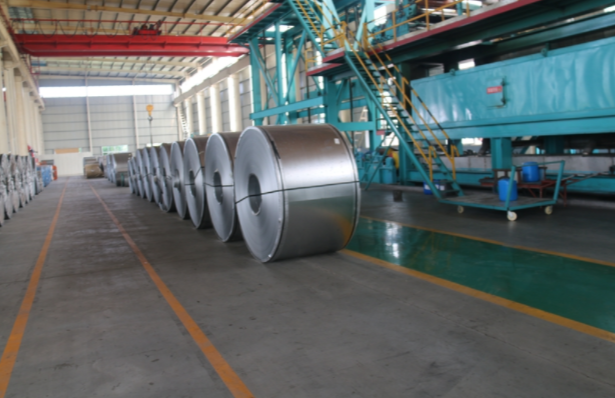



Galvanized Sheet - Process Flow

production process
a. The hot and cold rolled steel plate is degreasing by alkali, washed with water, dried and then entered into a horizontal (vertical) heating furnace heated by a radiant tube for annealing. A certain amount of hydrogen is introduced into the furnace to create a reducing atmosphere in the furnace;
b. The steel strip heated to a certain temperature is immersed in the zinc solution for hot-dip galvanizing under certain conditions. After the strip steel immersed in the zinc solution comes out of the zinc pot, an air knife is used to control the amount of galvanizing;
c. While the size of the spangle is controlled by the composition of liquid zinc, it is controlled by forced cooling. Before the spangle begins to spread, the small spangle product is quenched with a small spangle device to prevent the zinc liquid from continuing to spread and form small zinc flower;
d. After the hot-dip galvanized strip is cooled, the surface is smoothed, and finally, according to the application, the surface is passivated or directly produced into a color-coated coil.
Classification by coating method:
a. Hot-dip galvanized steel
b. Electro-galvanized steel sheet
Product indicators and representation
a. Zinc layer adhesion amount: in general, Z10, Z12, Z18 indicate that the amount of zinc per square meter is 100 grams, 120 grams, and 180 grams;
Use of galvanized sheet for construction
a. Building roofs or processing color-coated panels
b. Construction site fence
c, thermal insulation skin
d. Building and bridge formwork
e. Air-conditioning duct
f. Steel silo
g. Chimneys of rural houses
h, exhaust hood
i. Advertising boards
and many more…
Quality defects of galvanized sheet and matters needing attention
A. Common quality defects of galvanized sheet
1. Defect name: Galvanized peeling
Defect manifestation: Dezincification
Causes: Poor furnace temperature, improper substrate handling, etc.
2. Defect name: not galvanized
Defect performance: the surface part of the steel plate is not galvanized
Causes: poor raw materials, poor pretreatment degreasing, poor furnace temperature
3. Defect name: bad zinc flower
Defect performance: uneven size of spangles, no spangles
Cause: Poor heating in furnace area, poor cooling control
4. Defect name: Zinc scar
Defect performance: spot and granular zinc slag adhered to the surface of the steel plate
Cause: The scum or bottom slag in the zinc pot is attached to the steel belt
5. Defect Name: Oxidation
Defect performance: produce white rust
Cause: During storage, moisture in the air is absorbed and oxidation occurs
2Zn+O2 → 2ZnO
5ZnO+2CO2+3H2O →2ZnCO3·3Zn(OH)2
6. Defect name: black spot
Defect performance: black dots, block spots
Cause: Precipitation of impurities reacts with moisture, carbon dioxide, etc. in the atmosphere, or friction during transportation.
7. Defect name: side wave, middle wave
Defect performance: wavy edge or middle
Cause: poor raw material or poor working condition of tension leveling roller
8. Defect name: jagged edge
Defect performance: the edge has a sawtooth shape
Cause: When the raw material is cold-rolled, the edges are uneven and jagged
9. Defect name: uneven board surface
Defect performance: dents
Cause: Raw material pits or foreign matter on the surface of the roller
B. Matters needing attention in the transportation and storage of galvanized coils
1. Choose a ventilated place to store in the house to avoid dew erosion or moisture penetration
2. Confirm that the wrapping paper is not damaged during storage
3. Shorten the storage time as much as possible and protect its surface before corrosion
4. If the plate is subjected to abnormal external pressure, the zinc layer will partially fall off
5. Dirt and oil powder should be prevented from sticking to the surface, which will affect the galvanizing effect
6. A skid or a support frame should be added under the steel coil, and the number of stacking layers should not exceed two layers
7. The rain cloth should be covered during transportation, and the skids and rubber pads must be used, and fixed with ropes.